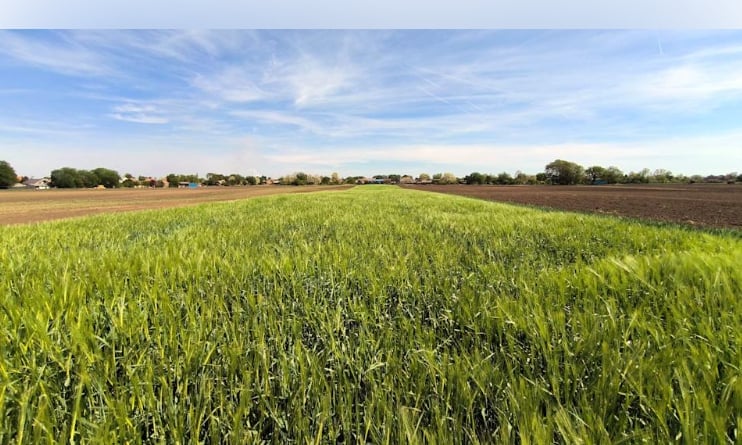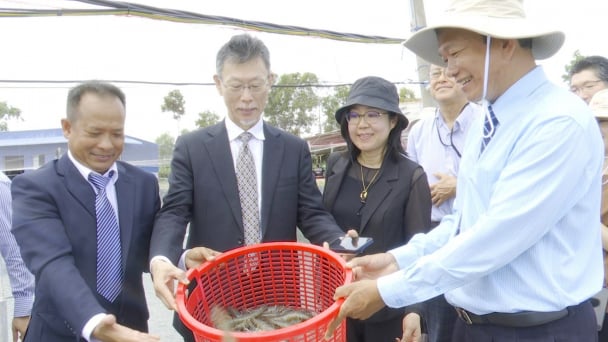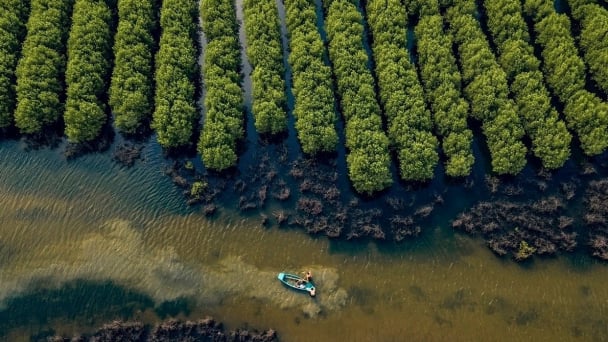June 17, 2025 | 09:15 GMT +7
June 17, 2025 | 09:15 GMT +7
Hotline: 0913.378.918
June 17, 2025 | 09:15 GMT +7
Hotline: 0913.378.918

Experimental farm uses innovative method to save over a billion gallons of water: 'If we can do it here, we can do it anywhere'
The water conservation is impressive considering the region was experiencing well over 100 degree heat in spring along with a drought. The National Park Service reported that the average temperature during the three summer months has increased 4 degrees Fahrenheit since 1950 because of the overheating planet.
On the 665-acre Oatman Flats Ranch, the team is using special techniques to sustain wheat, barley, and other crops despite the brutal conditions.
"I joke that this farm is a little better than Death Valley, but I'm not really joking," farm director Yadi Wang said.
The ranch is implementing regenerative organic farming in answer to drying rivers and arid, nutrient-poor dirt. The goal is to improve soil health and biodiversity as well as to limit water use and capture planet-warming carbon with vegetation. Started in 2021, the project has earned accolades and is considered a learning site by the Regenerative Organic Alliance, per Civil Eats.
Regenerative farming uses a mix of strategies, including Indigenous methods dating back thousands of years, to better manage farmland. They include crop rotation, vegetative cover, rotational grazing, and eliminating toxic pesticides and fertilizers, according to the alliance.
Natural fertilizers, for example, have already proved successful at providing bountiful harvests as part of other projects, including tomato research in Italy.
In the Arizona desert, farmers are also dealing with unprecedented droughts. NASA and other experts have linked planetary warming, caused largely by burning fossil fuels, to increased risks for water shortages and extreme weather events.
That's on top of the poor soil quality, resulting from decades of neglect and conventional farming practices. As a result, the Oatman team is rebuilding irrigation systems, clearing invasive trees, and using other regenerative practices.
Water-conserving crops were added to combat drought and overdraw from nearby farms that grow acres of alfalfa and corn for feed and fuels. The land also got a healthy dose of manure, all according to Civil Eats.
Sheep are natural mowers that also leave fertilizing droppings. Other species that have long been absent are returning, including dragonflies. Wang said the insects are proof of the advancements in water conservation.
"If we're going to hold on to farmland, we need a significant change in how we farm and what we farm," ranch owner Dax Hansen added.
The effort is paying off. In addition to the water gains, the team has doubled healthy organic matter in the dirt.
It's a mindset that can be applied in any environment at nearly any scale. At home, you can cultivate a sustainable backyard by letting nature take over. Natural lawns with native blooming plants can also boost local pollinator health. Government experts say that 35% of the world's food supply is reliant on struggling pollinators.
In Arizona, the ranchers also have them in mind. They spent $100,000 on native hedgerows that also help to retain soil and provide habitat for bees, birds, and other species, according to Civil Eats.
The team intends to continue restoring farmland in the extreme conditions. The project has been bolstered by government funds, but the goal is for a sustainable, "financially viable" system, per Civil Eats.
"You've seen what the land looks like in five years; imagine it in 10," Hansen said. "If we can do it here, we can do it anywhere."
TCD

(VAN) Poultry and pig production and the environment can be boosted through enhanced water technology, according to new research.
![Turning wind and rain into action: [4] Bringing climate bulletins to remote and isolated areas](https://t.ex-cdn.com/nongnghiepmoitruong.vn/608w/files/linhnhp/2025/06/14/1152-z6704423696987_15fd32ffc26d590d204d520c9dac6786-nongnghiep-151141.jpg)
(VAN) The Vietnam Agriculture and Nature Newspaper interviewed Mr. Vu Thai Truong, Acting Head of Climate Change and Environment at UNDP Vietnam, to gain deeper insight into how climate bulletins are delivered to farmers.

(VAN) In Tien Giang, a high-tech shrimp farm has developed a distinctive energy-saving farming model that has yielded promising results.
![Turning wind and rain into action: [3] 300.000 farmers benefit from agro-climatic bulletins](https://t.ex-cdn.com/nongnghiepmoitruong.vn/608w/files/news/2025/06/12/e5a48259d6a262fc3bb3-nongnghiep-125122.jpg)
(VAN) The agro-climatic bulletin has become a valuable tool for farmers in the Mekong Delta. After more than five years of implementation, the initiative is gradually being expanded nationwide.
![Turning wind and rain into action: [2] Providing forecasts to the people](https://t.ex-cdn.com/nongnghiepmoitruong.vn/608w/files/news/2025/06/12/e5a48259d6a262fc3bb3-nongnghiep-103927.jpg)
(VAN) In addition to improving the quality of hydrometeorological forecasts, putting forecast bulletins into practical use is crucial for production and disaster prevention.

(VAN) Blue carbon is receiving attention for its rapid absorption capacity and vast potential. It represents a promising nature-based solution to respond to climate change.